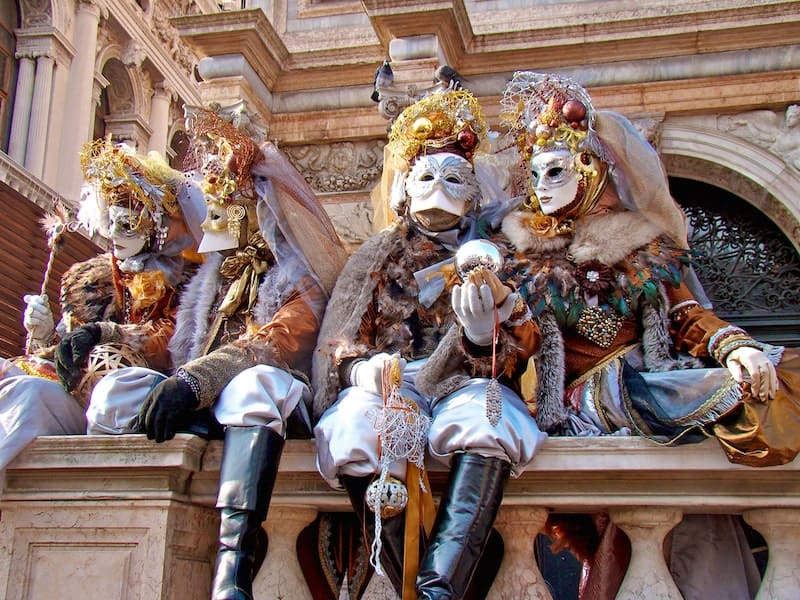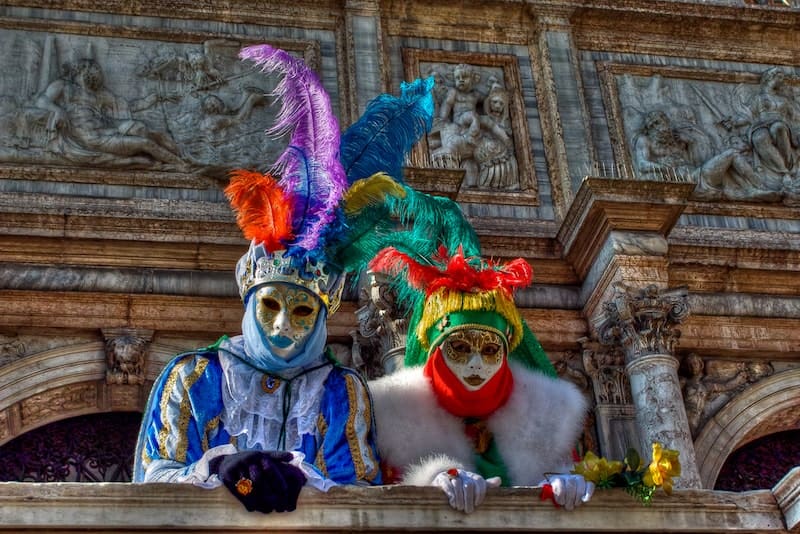The Venice Carnival is one of the most iconic and captivating events in the world, celebrated for its rich history, elaborate masks, and the enchanting atmosphere that envelops the floating city. With roots tracing back to the Middle Ages, the carnival has evolved into a vibrant festival that showcases the cultural and artistic heritage of Venice. Every year in February, thousands of visitors flock to Venice to immerse themselves in this magical experience, where tradition meets extravagance, and the city’s canals and streets come alive with colors and music. This guide will delve into the fascinating history, cherished traditions, and exciting events that make the Venice Carnival a must-see spectacle.
History and Traditions of the Venice Carnival
The origins of the Venice Carnival date back to the Middle Ages, with the first recorded mention in a document from 1296, when the Senate of the Republic of Venice declared the day before Lent as a public holiday. The carnival was a period of celebration, marked by exuberant festivities where Venetians of all classes could mingle freely. The use of masks played a crucial role, as they allowed people to conceal their identities, thereby suspending social norms and encouraging a sense of liberation and equality among participants.
During the Renaissance, the Venice Carnival reached its peak of splendor, becoming famous throughout Europe for its elaborate costumes, opulent parties, and theatrical performances. However, by the 18th century, the carnival experienced a period of decline. The fall of the Venetian Republic in 1797 and subsequent changes in political power led to the suppression of many traditional celebrations, including the carnival.
It wasn’t until the 20th century that the Venice Carnival experienced a revival. In 1979, the Italian government decided to bring back the event as a way to celebrate Venice’s rich cultural heritage and attract tourism. Today, the Venice Carnival is once again one of the most celebrated events in the world, combining historical traditions with modern festivities, and drawing visitors from across the globe to experience its unique blend of history, culture, and fantasy.
The Significance and Craftsmanship of Venetian Masks

The Venetian masks are among the most recognizable symbols of the Venice Carnival, steeped in history and cultural significance. Each mask carries its own meaning and purpose, rooted in the social dynamics of Venice’s past.
Bauta is perhaps the most iconic of all Venetian masks. Characterized by its square jawline, pointed chin, and no mouth opening, it was often paired with a black cape and tricorn hat. Historically, the Bauta was used to conceal the wearer’s identity during important political decisions and social gatherings, allowing them to speak freely without revealing their true identity.
Moretta, on the other hand, was a mask worn exclusively by women. It was a small, oval mask, often made of velvet, which covered the face completely except for the eyes. What made the Moretta unique was its lack of straps; instead, it was held in place by biting down on a button inside the mask. This feature made the Moretta a symbol of silence and mystery, adding to the allure and elegance of Venetian women during the carnival.
The Plague Doctor is perhaps the most eerie of Venetian masks, characterized by its long, beak-like nose. Originally designed by French physician Charles de Lorme during the 17th century plague, the mask was intended to protect doctors from disease. It has since become a powerful symbol during the Venice Carnival, representing the macabre history of the city intertwined with its periods of opulence and festivity.
Today, these masks are not only worn during the carnival but are also celebrated as cultural artefacts. Skilled artisans in Venice continue to construct these masks by hand, using traditional techniques passed down through generations. Visitors can find workshops throughout the city where these intricate pieces are made, offering a glimpse into the rich artisanal heritage of Venice. The masks have transcended their original purpose, becoming artistic symbols of Venice’s mysterious and enchanting past.
Key Events of the Venice Carnival
Volo dell’Angelo
The official opening of the Venice Carnival kicks off with the spectacular Volo dell’Angelo in Piazza San Marco. This event features a performer, traditionally a young woman, descending gracefully from the Campanile of San Marco to the centre of the square. It’s a symbolic moment that marks the beginning of the celebrations. The event typically takes place on the first Sunday of the carnival, around midday, and is one of the most anticipated moments of the festival.
Festa delle Marie
This historical parade, known as La Festa delle Marie, celebrates the beauty and grace of twelve young Venetian women who are honoured and dressed in traditional costumes. The parade starts from San Pietro di Castello and ends in Piazza San Marco, where the women are presented to the public. The event usually occurs on the second Saturday of the carnival, drawing large crowds to witness this tribute to Venice’s rich history.
Best Mask Contest
Each day in Piazza San Marco, the Best Mask Contest takes place, where participants display their elaborate and creative costumes. These contests are held in the afternoons, allowing both participants and spectators to immerse themselves in the artistic and playful spirit of the carnival. Anyone can participate by registering in advance, making it a lively and inclusive event.
Masked Balls
The Venice Carnival is renowned for its Masked Balls hosted in historic Venetian palaces. One of the most famous is the Ballo del Doge, a lavish event that attracts an international elite, offering a night of opulence, music, and dance. Tickets for these exclusive events are highly sought after, and it’s advisable to book well in advance.
Show and parades
Throughout the carnival, Venice’s streets are filled with shows and parades, featuring live music, theatre performances, and street artists. These events are scattered throughout the city, providing entertainment at every turn, and allowing visitors to experience the vibrant and artistic atmosphere of Venice during its most celebrated time of year.
How to Travel to Venice and Get Around the City During Carnival

Traveling to Venice
Venice is easily accessible from major Italian cities like Milan, Florence, Rome, and Naples, thanks to the high-speed train services offered by Italo. These trains connect Venice with other major cities, making it convenient for visitors to travel to the carnival. For instance, you can travel by train from Rome to Venice with Italo High-Speed and reach the carnival in about 4 hours.
Getting Around Venice
During the Venice Carnival, the best way to explore the city is on foot, allowing you to wander through the enchanting alleys, squares, and bridges at your own pace. However, Venice’s vaporetto system is essential for longer trips across the city, especially along the Grand Canal and to the outer islands. Given the influx of visitors during the carnival, it’s wise to plan your movements in advance, considering potential crowds and ensuring you don’t miss any key events.
Suggestions for Accommodations and Local Restaurants
Accommodations
For those looking for a luxurious stay, Venice offers several iconic five-star hotels like the Gritti Palace and Hotel Danieli, both of which are rich in history and elegance, providing unparalleled views of the Grand Canal and the Venetian lagoon. For travelers seeking a more intimate experience, there are numerous boutique hotels and charming bed & breakfasts located within the historic center. Given that the Venice Carnival is a peak tourist season, it’s highly recommended to book your accommodation well in advance to secure the best options.
Restaurants
Venice is renowned for its exquisite cuisine, and during the carnival, you can enjoy a variety of local dishes in some of the city’s most celebrated dining establishments. For a lavish dining experience, Ristorante Quadri in Piazza San Marco offers fine Venetian cuisine with a stunning view of the square. If you prefer a more traditional setting, head to Osteria alle Testiere, a small and intimate restaurant known for its authentic dishes such as baccalà mantecato (creamed cod), sarde in saor (sweet and sour sardines), and seafood risottos. Be sure to indulge in the local culinary delights to complete your Venetian experience.
Useful Tips and Contact Information for the Venice Carnival

To fully enjoy the Venice Carnival, it’s essential to be well-prepared. Wear comfortable shoes as you will be walking a lot through the city’s narrow streets and bridges. The weather in February can be unpredictable, so dress in layers to adjust easily to temperature changes. Don’t forget to bring or buy a traditional Venetian mask to immerse yourself in the carnival spirit—it’s an experience like no other! Also, stay vigilant in crowded areas to ensure your belongings are safe, as the carnival attracts large numbers of visitors.
For more detailed information, visitors can refer to the official website of the Venice Carnival where they can find up-to-date schedules, purchase tickets for events, and learn more about the festivities. Additionally, the Venice Tourist Office is a valuable resource for travel information, accommodations, and local insights.
In conclusion, the Venice Carnival offers an unparalleled experience that blends history, culture, and entertainment in one of the most beautiful cities in the world. Whether the enchanting masks, the vibrant events, or simply the chance to immerse yourself in Venice’s magical atmosphere draws you, this is an event not to be missed.
Planning ahead is crucial to secure your spot and make the most of this extraordinary celebration. By preparing early, you’ll ensure that your time at the Venice Carnival is truly unforgettable, allowing you to fully enjoy all the wonders that this iconic festival has to offer.


